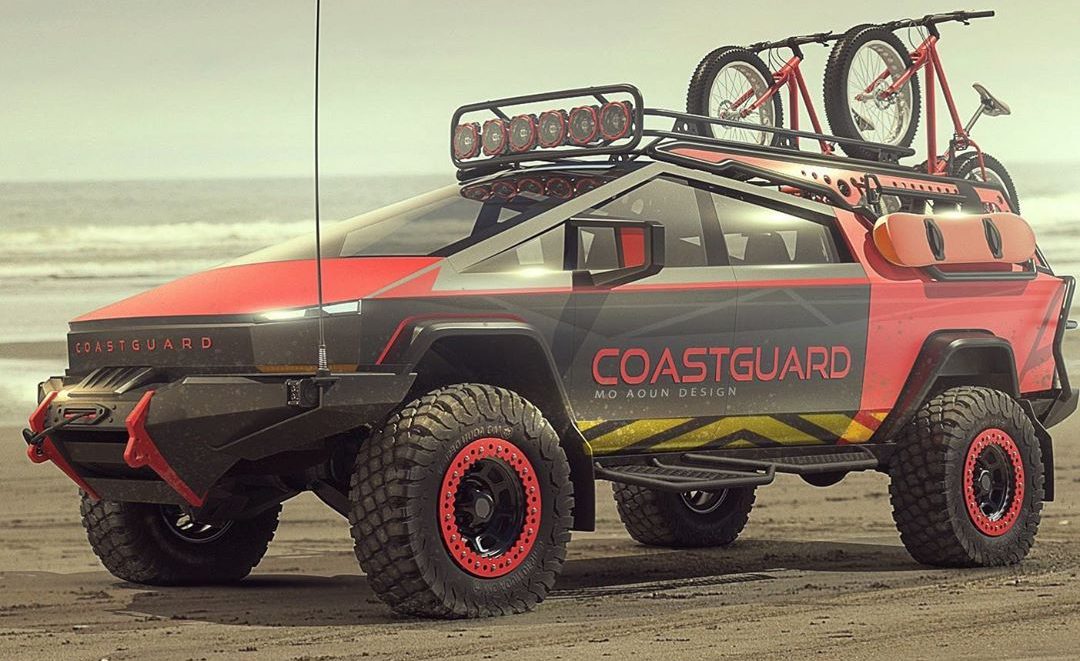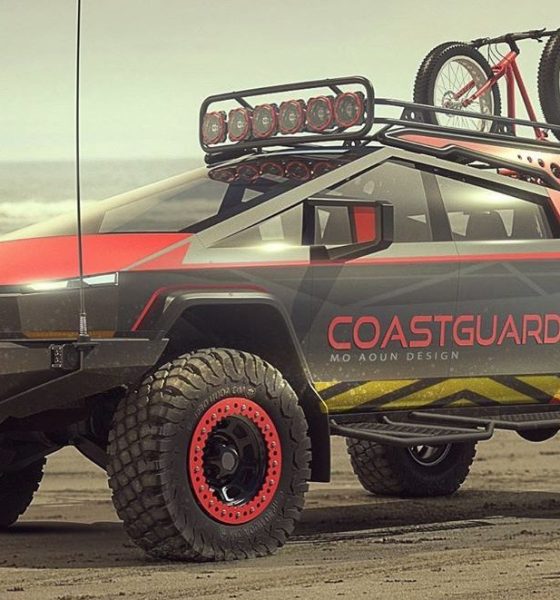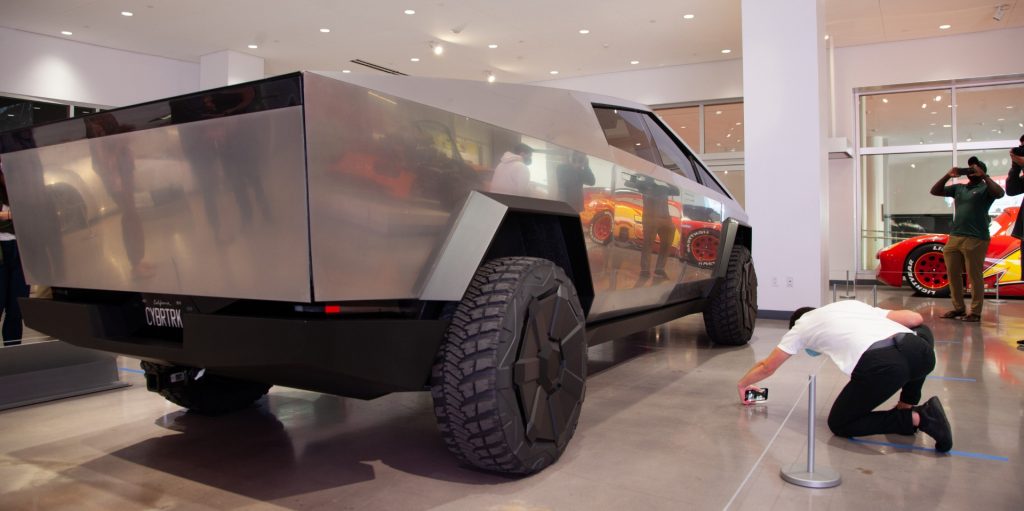

News
Tesla Cybertruck’s potential amphibious capabilities are starting to become realistic
In a recent lighthearted post, Tesla CEO Elon Musk referenced the Cybertruck’s potential amphibious capabilities once more. Musk’s tweet was a response to a rather humorous concept video featuring the all-electric pickup being used as a boat. And while such a concept may be farfetched for the skeptics, the idea of an amphibious vehicle may actually be pretty feasible.
The amusing render was created by Slav Popovski, the same 3D artist that came up with a realistic concept video of the next-gen Tesla Roadster SpaceX Package’s 0-60 mph launch. Musk, for his part, stated that Tesla could probably give the all-electric pickup a similar function. “I think we could make it work,” the CEO noted. This echoed a previous tweet that Musk posted in April, when he noted that the Cybertruck would “float for a while” when traversing deep waters.
Recent images of the Tesla Cybertruck at the Petersen Automotive Museum have revealed that the vehicle may actually be designed to resist being breached with water. As indicated by pictures from the Tesla community, several sections of the Cybertruck’s underbody seem to be watertight, and the vehicle’s suspension area seemed to be sealed as well. This suggests that Elon Musk’s statements about the Cybertruck’s amphibious capabilities may be less outlandish than expected.

Musk has been pretty open about his love for vehicles that can travel on both land and water. In 2013, Musk purchased the actual Lotus Esprit S1 movie prop from the 1977 James Bond film The Spy Who Loved Me, which became iconic due to its capability to transform from a sports car into a submarine. Musk would later joke that he was disappointed to find out that the Lotus did not really transform into a submarine, and that he would probably attempt an amphibious vehicle using Tesla tech.
The CEO revisited this idea in the 2019 Annual Shareholder Meeting, when he stated that a submarine car is “technically possible.” Musk did admit that the market for such vehicles would be small, but he suggested that there will probably be a lot of enthusiasm around the project.
A novel amphibious car has actually been attempted over ten years ago by Swiss niche automaker Rinspeed. During the Geneva Motor Show in 2008, the company took the wraps off its all-electric sQuba amphibious sports car. The vehicle ran on lithium ion batteries and was built on top of a Lotus Elise, which actually makes it pretty similar to the original Tesla Roadster, at least to some degree.

Granted, the sQuba was slower than Tesla’s sports car with its top speed of 75 mph, but it does have the capability to travel over water, and up to 33 ft underwater. The vehicle even came equipped with scuba tanks for its two passengers, which are incredibly useful when the vehicle is in its submarine configuration. Unfortunately, the sQuba has so far not made it to production, with Rinspeed founder and CEO Frank M. Rinderknecht stating that the appeal of such a vehicle is very limited due to the fact that it was mostly a toy for the wealthy.
But the Cybertruck is no niche vehicle, nor is it a novel toy for the rich. Starting at less than $40,000 for its RWD variant, the Cybertruck is made for utility and actual, tough work. This means that if the Cybertruck were to have actual amphibious abilities, it could have practical, real-world uses. The vehicle could be used as a rescue pickup for the Coast Guard, for example, since it could function as a boat to some degree.
Of course, these are all speculations for now. That being said, Elon Musk does have a reputation for bringing to market products and features that were initially thought of as a joke. The Boring Company’s Not-a-Flamethrower is one of these, and Tesla’s amusing Emissions Testing Mode (aka Fart Mode) is another. With these in mind, and with the Cybertruck seemingly being designed to withstand water, perhaps the idea of an amphibious all-electric pickup is not too farfetched after all.

News
Tesla (TSLA) receives “Buy” rating and $551 PT from Canaccord Genuity
He also maintained a “Buy” rating for TSLA stock over the company’s improving long-term outlook, which is driven by autonomy and robotics.

Canaccord Genuity analyst George Gianarikas raised his Tesla (NASDAQ:TSLA) price target from $482 to $551. He also maintained a “Buy” rating for TSLA stock over the company’s improving long-term outlook, which is driven by autonomy and robotics.
The analyst’s updated note
Gianarikas lowered his 4Q25 delivery estimates but pointed to several positive factors in the Tesla story. He noted that EV adoption in emerging markets is gaining pace, and progress in FSD and the Robotaxi rollout in 2026 represent major upside drivers. Further progress in the Optimus program next year could also add more momentum for the electric vehicle maker.
“Overall, yes, 4Q25 delivery expectations are being revised lower. However, the reset in the US EV market is laying the groundwork for a more durable and attractive long-term demand environment.
“At the same time, EV penetration in emerging markets is accelerating, reinforcing Tesla’s potential multi‑year growth runway beyond the US. Global progress in FSD and the anticipated rollout of a larger robotaxi fleet in 2026 are increasingly important components of the Tesla equity story and could provide sentiment tailwinds,” the analyst wrote.
Tesla’s busy 2026
The upcoming year would be a busy one for Tesla, considering the company’s plans and targets. The autonomous two-seat Cybercab has been confirmed to start production sometime in Q2 2026, as per Elon Musk during the 2025 Annual Shareholder Meeting.
Apart from this, Tesla is also expected to unveil the next-generation Roadster on April 1, 2026. Tesla is also expected to start high-volume production of the Tesla Semi in Nevada next year.
Apart from vehicle launches, Tesla has expressed its intentions to significantly ramp the rollout of FSD to several regions worldwide, such as Europe. Plans are also underway to launch more Robotaxi networks in several more key areas across the United States.
News
Waymo sues Santa Monica over order to halt overnight charging sessions
In its complaint, Waymo argued that its self-driving cars’ operations do not constitute a public nuisance, and compliance with the city’s order would cause the company irreparable harm.

Waymo has filed a lawsuit against the City of Santa Monica in Los Angeles County Superior Court, seeking to block an order that requires the company to cease overnight charging at two facilities.
In its complaint, Waymo argued that its self-driving cars’ operations do not constitute a public nuisance, and compliance with the city’s order would cause the company irreparable harm.
Nuisance claims
As noted in a report from the Los Angeles Times, Waymo’s two charging sites at Euclid Street and Broadway have operated for about a year, supporting the company’s growing fleet with round-the-clock activity. Unfortunately, this has also resulted in residents in the area reportedly being unable to sleep due to incessant beeping from self-driving taxis that are moving in and out of the charging stations around the clock.
Frustrated residents have protested against the Waymos by blocking the vehicles’ paths, placing cones, and “stacking” cars to create backups. This has also resulted in multiple calls to the police.
Last month, the city issued an order to Waymo and its charging partner, Voltera, to cease overnight operations at the charging locations, stating that the self-driving vehicles’ activities at night were a public nuisance. A December 15 meeting yielded no agreement on mitigations like software rerouting. Waymo proposed changes, but the city reportedly insisted that nothing would satisfy the irate residents.
“We are disappointed that the City has chosen an adversarial path over a collaborative one. The City’s position has been to insist that no actions taken or proposed by Waymo would satisfy the complaining neighbors and therefore must be deemed insufficient,” a Waymo spokesperson stated.
Waymo pushes back
In its legal complaint, Waymo stated that its “activities at the Broadway Facilities do not constitute a public nuisance.” The company also noted that it “faces imminent and irreparable harm to its operations, employees, and customers” from the city’s order. The suit also stated that the city was fully aware that the Voltera charging sites would be operating around the clock to support Waymo’s self-driving taxis.
The company highlighted over one million trips in Santa Monica since launch, with more than 50,000 rides starting or ending there in November alone. Waymo also criticized the city for adopting a contentious strategy against businesses.
“The City of Santa Monica’s recent actions are inconsistent with its stated goal of attracting investment. At a time when the City faces a serious fiscal crisis, officials are choosing to obstruct properly permitted investment rather than fostering a ‘ready for business’ environment,” Waymo stated.
News
Tesla FSD v14.2.2 is getting rave reviews from drivers
So far, early testers have reported buttery-smooth drives with confident performance, even at night or on twisty roads.

Tesla Full Self-Driving (Supervised) v14.2.2 is receiving positive reviews from owners, with several drivers praising the build’s lack of hesitation during lane changes and its smoother decision-making, among others.
The update, which started rolling out on Monday, also adds features like dynamic arrival pin adjustment. So far, early testers have reported buttery-smooth drives with confident performance, even at night or on twisty roads.
Owners highlight major improvements
Longtime Tesla owner and FSD user @BLKMDL3 shared a detailed 10-hour impression of FSD v14.2.2, noting that the system exhibited “zero lane change hesitation” and “extremely refined” lane choices. He praised Mad Max mode’s performance, stellar parking in locations including ticket dispensers, and impressive canyon runs even in dark conditions.
Fellow FSD user Dan Burkland reported an hour of FSD v14.2.2’s nighttime driving with “zero hesitations” and “buttery smooth” confidence reminiscent of Robotaxi rides in areas such as Austin, Texas. Veteran FSD user Whole Mars Catalog also demonstrated voice navigation via Grok, while Tesla owner Devin Olsen completed a nearly two-hour drive with FSD v14.2.2 in heavy traffic and rain with strong performance.
Closer to unsupervised
FSD has been receiving rave reviews, even from Tesla’s competitors. Xpeng CEO He Xiaopeng, for one, offered fresh praise for FSD v14.2 after visiting Silicon Valley. Following extended test drives of Tesla vehicles running the latest FSD software, He stated that the system has made major strides, reinforcing his view that Tesla’s approach to autonomy is indeed the proper path towards autonomy.
According to He, Tesla’s FSD has evolved from a smooth Level 2 advanced driver assistance system into what he described as a “near-Level 4” experience in terms of capabilities. While acknowledging that areas of improvement are still present, the Xpeng CEO stated that FSD’s current iteration significantly surpasses last year’s capabilities. He also reiterated his belief that Tesla’s strategy of using the same autonomous software and hardware architecture across private vehicles and robotaxis is the right long-term approach, as it would allow users to bypass intermediate autonomy stages and move closer to Level 4 functionality.








